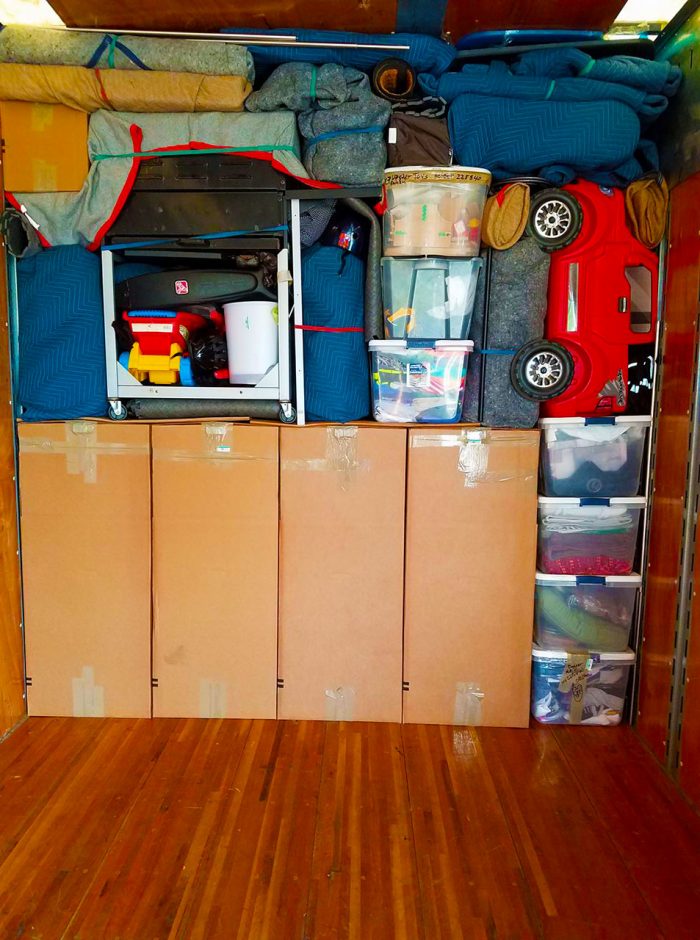Weight vs. Cubic Feet Moving Estimates
What’s the difference between weight and cubic feet moving estimates — and does it matter for your move?
Weight moving estimates are based on the total weight of the items you need to move. Cubic feet moving estimates are based on the total volume of your possessions — or how much space they take up.
So, which type of estimate should you trust? Weight or cubic feet based? In reality, it doesn’t matter which type of estimate you get.
Your focus really should be on hiring one of the top moving companies so moving day doesn’t have any surprises. Good long-distance movers usually provide a binding estimate after inventorying your home — and in that case, the weight vs. volume issue doesn’t matter.
Still, it’s helpful to understand the two types of estimates. In this article, we’ll help you understand the difference so you can make an informed decision when getting moving quotes.
Weight vs. cubic feet
Whether you’re planning a local or long-distance move, trying to understand what the weight and cubic feet of your belongings means can feel intimidating and confusing. By understanding how movers calculate estimates using these different methods, you can feel more confident as you compare quotes.
Moving estimates by weight

Moving estimates by weight are the moving industry standard. Most major van lines offer quotes based on the weight of your shipment.
While moving company weight estimates can vary, the major benefit to them is they can be verified by the U.S. Department of Transportation (USDOT). This is a very important distinction between weight- and volume-based estimates. If you have a dispute with your mover, you can request the USDOT-certified weight tickets to verify everything.
The method for weighing all your stuff is surprisingly straightforward. Crews weigh the moving truck prior to loading, then again once everything is loaded. The difference between the two is the actual weight of your move.
Cubic feet estimates
A cubic foot is determined by length x width x height. Let’s say you have a piece of furniture that is three feet long, one foot wide, and three feet tall. To determine its volume in cubic feet, you’d multiply the three figures: 3 x 1 x 3 = 9 cubic feet.
Cubic footage estimates are often viewed as a less-accurate way to determine the cost of your move because they can’t be verified by the USDOT. Your move’s cost is determined by the total volume of your items — how much physical space they take up inside the moving truck.
Unfortunately, common moving scams often involve giving cubic feet moving estimates because they can be easier to game. For example, packing the truck poorly or using generous measurements can quickly add to the total cubic footage of a move. Meet in-person with a moving company representative whenever possible to ensure you’re getting an accurate estimate.
However, some of the best professional movers we work with provide quotes in terms of cubic footage with no problems. Cubic feet measurements are also helpful when using portable moving container companies or moving truck rentals you’ll be packing yourself. Cubic footage can give you an idea of how much space you’ll need so you get the right number of containers or the right size moving truck.
Weight vs cubic feet moving estimates: Industry standards
While your exact totals will vary, here are some basic rough estimates for different move sizes:
- Studio apartment: 1,800 pounds, 250 cubic feet
- 1-bedroom home or apartment: 2,200–3,200 pounds, 300–400 cubic feet
- 2-3 bedroom home: 5,000–9,000 pounds, 400–900 cubic feet
- 4-5 bedroom home: 10,000–13,000+ pounds, 1,000–1,300+ cubic feet
As a general rule, each full-size room in your house contains 1,000––1,500 pounds of items. This total accounts for smaller spaces like closets and bathrooms that wouldn’t typically be considered a “full room.”
Most moving truck and shipping container companies list their capacities in both maximum weight and cubic feet so you don’t risk overloading your truck or container.
Fortunately, most trucks and containers have a much higher weight capacity than you are likely to reach with your household goods.
So, how do your movers actually provide that initial estimate? It’s more art than science. For both types of estimates, movers estimate how many boxes will be needed to pack your items. They use an industry-standard weights and measurement spreadsheet to help calculate the size of different items.
By taking an accurate inventory, professional movers can generally provide a good estimate for how many boxes you’ll need, as well as the expected total weight or volume of your move.
In other words, the inventory list is what matters most, regardless of whether you’re getting a weight or cubic feet estimate.
Weight vs cubic feet: How much does it matter?
If you have a binding estimate and an accurate inventory list, then the actual weight or cubic footage of your move shouldn’t matter. The final price will be based on the inventory list (“Table of Measurements” or “Cube Sheet”).
But what if the inventory list isn’t accurate? Let’s say your moving company shows up on the move date and your garage was missing from the estimate. Yes, this happens (though it’s less likely to happen when working with a legitimate, professional moving company).
The moving company isn’t going to move this stuff for free. Assuming they can fit it all on the moving truck, they’ll likely give you two options:
- Rewrite the quote and calculate a new binding price for the move. You’ll pay whatever flat rate both parties agree on based on the updated inventory.
- Change the estimate from binding to non-binding. A non-binding estimate means the final cost will be either the total weight multiplied by the cost-per-pound or total volume multiplied by cost per cubic foot.
With the second option, if the stuff that was missing on the original estimate weighs 1,000 pounds and the mover’s rate is $1 per pound, you’ll owe an extra $1,000 to cover the cost of the additional items.
The big risk with non-binding estimates is that it’s hard to estimate how much those extra items will weigh. And you won’t know until after they’ve packed everything up and gone to the scales. In most cases, it makes sense to just rewrite the binding estimate and agree on a final price.
Weight vs cubic feet moving estimates: Which one is the best?
Bottom line: Hire reputable movers and you won’t need to worry about weight vs. cubic feet moving estimates. Your binding estimate’s final price will be determined from an inventory list of the actual number of household goods you have. As long as that list is accurate, you won’t be responsible for extra charges if your items weigh a bit more than expected.
So, if you have 250 items listed on your “Cube Sheet” and end up having 300 items on moving day, your price will likely increase regardless of weight or volume. On the other hand, if the weight or volume is more than expected but all 250 items were already accounted for, your costs wouldn’t increase.
Get quotes from multiple movers, and make sure you are working with reliable moving companies with a strong reputation. Ask questions to ensure you are getting a binding estimate based on an inventory list, and you can move forward with confidence.
Best movers for weight vs. cubic feet moving estimates
To ensure you have a quality moving experience, the most important thing to keep in mind is whether the company has a good reputation and transparent quoting process. This ultimately matters more than whether that company bases its estimates off of weight or cubic feet.
Here are some of our picks for top movers, as well as the type of estimates that will matter most for each type of move.
Full-service movers
Full-service movers take care of all the loading, unloading, and transportation for your move. When you request a free quote, they’ll typically send a representative to your home or schedule a virtual walkthrough to inventory your items. From there, they will make either a weight- or cubic feet-based estimate.
Reputable full-service movers like American Van Lines and Mayzlin Relocation offer weight-based binding quotes based on your inventory and have reputations for stellar customer service.
Moving container companies
Moving container companies are a good balance of full-service and DIY moves. While you are responsible for packing, loading, and unloading, the company will transport the container from your old home to your new home, which means you don’t have to worry about driving.
When using a moving container company, it’s best to try to calculate the cubic feet of your items so you know what size container (or how many containers) you need. Some companies, like PODS, offer multiple container sizes. Others, such as U-Pack, allow you to rent multiple containers based on your estimated needs.
| Company | Quote | Rating | Price |
|---|---|---|---|
U-Pack 
|
Check prices |
|
|
PODS 
|
Check prices |
|
|
1-800-Pack-Rat 
|
Check prices |
|
Rental trucks
Moving truck rentals are a good option for households looking to move on a budget and have the time and ability to pack, load, and transport everything on their own. Quality truck rental companies like Budget Truck Rental and Penske Truck Rental are transparent about the weight limits and cubic footage capacity of their different truck sizes.
As with using moving container companies, it’s easier to estimate the cubic feet of your items for a DIY move. Taking a rough estimate will help you figure out what size of moving truck you need to fit everything.
|
|
|
|
FAQs about weight vs. cubic feet moving estimates
Is it better to move by weight or cubic feet?
Whether it is better to move by weight or cubic feet depends on your type of move.
When hiring professional moving services, it is generally better to get estimates by weight. This is because weight-based estimates can be verified when your mover obtains a weight ticket through the U.S. Department of Transportation.
For a DIY move, estimating the cubic feet is better, as this will help you determine how big of a rental truck you need.
How do movers determine cubic feet?
Movers determine cubic feet by using an industry-standard measurement sheet. This helps them determine how many boxes will be needed to pack everything. For larger items like sofas or dining room furniture, they can take actual measurements of the height, width, and depth to determine the cubic feet.
How do I calculate my weight for moving?
You can calculate your weight for moving by using an online moving cost calculator or weight calculator. Another easy way to calculate your moving weight is to follow a moving industry standard — each full-size room contains between 1,000 and 1,500 pounds of items.
What is the average weight of a one-bedroom move?
The average weight of a one-bedroom move is between 2,200 and 3,200 pounds. This total includes the weight of the other rooms in the house or apartment.
How much does an average move weigh?
The average move weighs between 1,000 and 1,500 pounds per full-size room. For a typical two- to three-bedroom home, expect a total weight between 4,000 and 9,000 pounds, depending on the total number of items being moved.
Not what you were looking for?
Check out other categories that can help you find the information you need!










